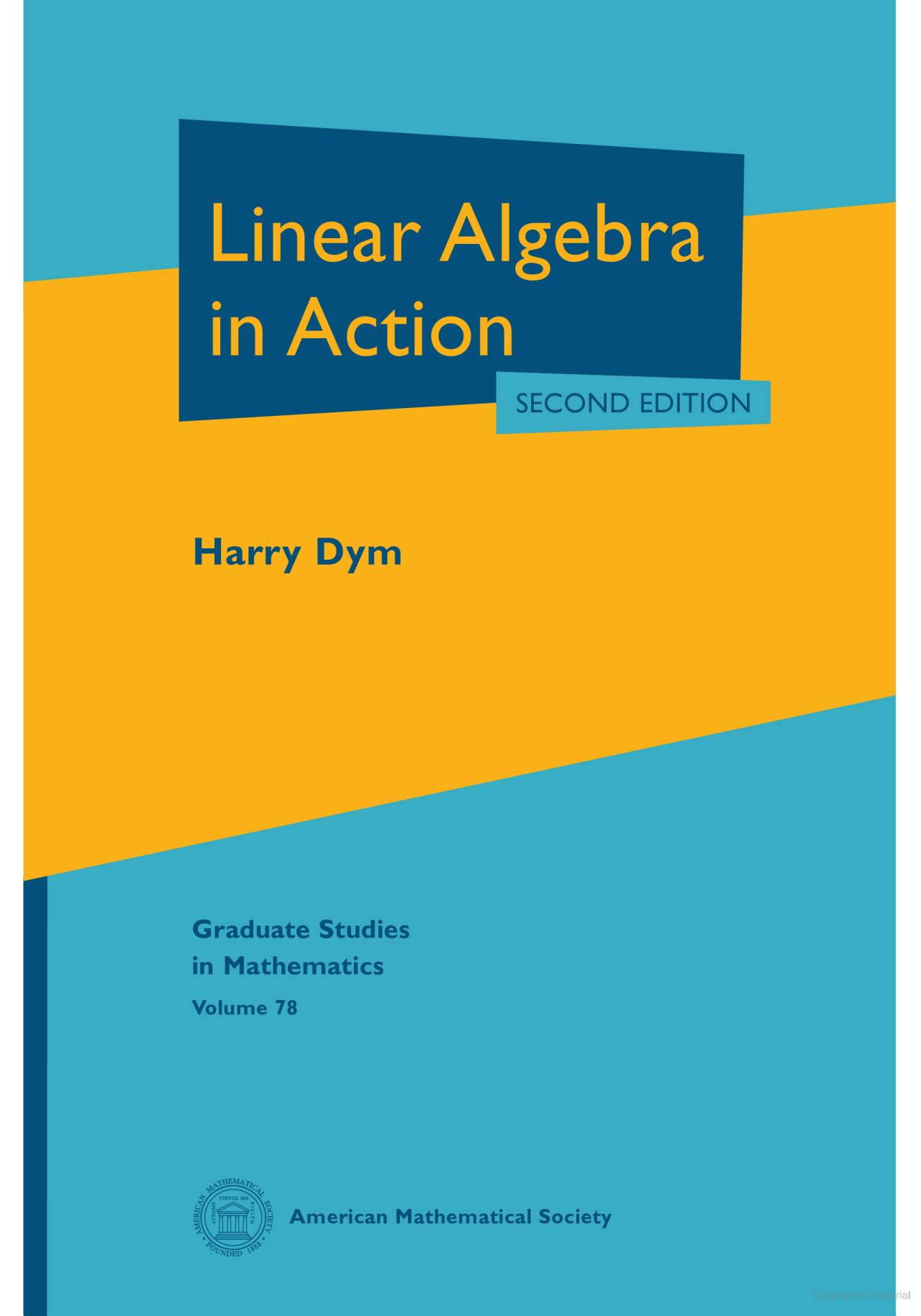LINEAR ALGEBRA TRUE OR FALSE PAST QUESTIONS WITH SOLUTIONS
1.
A linear system whose equations are all
homogeneous must be consistent.
True
2.
Multiplying a row of an augmented matrix through
by zero is an acceptable elementary row operation.
False
3.
The linear system
x - y = 3
2x - 2y = k
cannot have a unique solution, regardless of
the value of k.
True
4.
A single linear equation with two or more
unknowns must have infinitely many solutions.
True
5.
If the number of equations in a linear system
exceeds the number of unknowns, then the system must be inconsistent.
False
6.
If each equation in a consistent linear system
is multiplied through by a constant c, then all solutions to the new system can
be obtained by multiplying solutions from the original system by c.
False
7.
Elementary row operations permit one row of an
augmented matrix to be subtracted from another.
True
8.
The linear system with corresponding augmented
matrix
[2 -1 4
0 0 -1]
is consistent.
False
9.
If a matrix is in RREF, then it is also in REF.
True
10.
If an elementary row operation is applied to a
matrix that is in REF, the resulting matrix will still be in REF.
False
11.
Every matrix has a unique row echelon form.
False
12.
A homogeneous linear system in n unknowns whose
corresponding augmented matrix has a RREF with r leading 1's has n-r free
variables.
True
13.
All leading 1's in a matrix in REF must occur in
different columns.
True
14.
If every column of a matrix in REF has a leading
1, then all entries that are not leading 1's are zero.
False
15.
If a homogeneous linear system of n equations in
n unknowns has a corresponding augmented matrix with a RREF containing n
leading 1's, then the linear system has only the trivial solution.
True
16.
If the RREF of the augmented matrix for a linear
system has a row of zeros, then the system must have infinitely many solutions.
False
17.
If a linear system has more unknowns than
equations, then it must have infinitely many solutions.
False
18.
Every matrix has a unique RREF.
True
19.
Every matrix has a unique REF.
False
20.
The RREF and all REF's of a matrix have the same
number of zero rows.
True
21.
The following matrix has no main diagonal:
[1 2 3
4 5 6]
True
22.
If A and B are (2x2) matrices, then AB = BA.
False
23.
For every matrix A, it is true that (A^T)^T = A.
True
24.
For every square matrix A, it is true that
tr(A^T) = tr(A).
True
25.
If A is an (n×n) matrix and c is a scalar, then
tr(cA) = c tr(A)
True
26.
If A, B, and C are matrices of the same size
such that
A - C = B - C, then A = B.
True
27.
If A, B, and C are square matrices of the same
order such that AC = BC, then A = B.
True
28.
If AB+BA is defined, then A and B are square
matrices of the same size.
True
29.
Any matrix A times the identity matrix equals A.
True
30.
A square matrix with a row or column of zeros is
singular.
True
31.
If a product of matrices is singular, then at
least one of the factors must be singular.
True
32.
(A±B)^T = A^T ± B^T
True
33.
(kA)^T = kA^T
True
34.
The transpose of a product of any number of
matrices is the product of the transposes in the reverse order.
True
35.
If A is an invertible matrix, then A transpose
is also invertible and the inverse of the transpose equals the transpose of the
inverse.
True
36.
A matrix with a row or column of zeros can have
an inverse.
False
37.
Two nxn matrices, A and B, are inverses of one
another if and only if AB = AB = 0.
False
38.
For all square matrices A and B of the same size,
it is true that (A+B)²=A²+2AB+B².
False
39.
For all square matrices A and B of the same
size, it is true that A²-B²=(A-B)(A+B).
False
40.
If A and B are invertible matrices of the same
size, then AB is invertible and (AB)-¹=A-¹B-¹
False
41.
If A and B are matrices of the same size and k
is a constant, then (kA+B)^T = kA^T + B^T
True
42.
If A is an invertible matrix, then so is A^T.
True
43.
A square matrix containing a row or column of
zeros cannot be invertible.
True
44.
The sum of two invertible matrices of the same size
must be invertible.
False
45.
Every elementary matrix is invertible, and the
inverse is also an elementary matrix.
True
46.
The product of two elementary matrices of the
same size must be an elementary matrix.
False
47.
Every elementary matrix is invertible.
True
48.
If A and B are row equivalent, and if B and C
are row equivalent, then A and C are row equivalent.
True
49.
If A is an nxn matrix that is not invertible,
then the linear system Ax=0 has infinitely many solutions.
True
50.
If A is an nxn matrix that is not invertible,
then the matrix obtained by interchanging two rows of A cannot be invertible.
True
51.
If A is invertible and a multiple of the first
row of A is added to the second row, then the resulting matrix is invertible.
True
52.
An expression of an invertible matrix A as a
product of elementary matrices is unique.
False
53.
The transpose of an upper triangular matrix is
an upper triangular matrix.
False
54.
If A is a 3 X 3 matrix and B is obtained from A
by multiplying the first column by 4 and multiplying the third column by
$$\frac{3)(4)$$, then det(B)=3 det(A).
True
55.
If $$(A^2)$$ is a symmetric matrix, then A is a
symmetric matrix.
False
56.
Every elementary matrix is invertible.
True
57.
The inverse of an invertible lower triangular
matrix is an upper triangular matrix.
False
58.
If E is an elementary matrix, then Ex=0 has only
the trivial solution.
True
59.
The sum of an upper triangular matrix and a
lower triangular matrix is a diagonal matrix.
False
60.
A linear system whose equations are all
homogeneous must be consistent.
True
61.
If A and B are row equivalent matrices, then the
linear systems Ax= 0 and Bx= 0 have the same solution set.
True
62.
If A and B are matrices such that AB is defined,
then it is true that $${(AB)^T} = {A^T}{B^T}$$ .
False
63.
Two square matrices that have the same determinant
must have the same size.
False
64.
The sum of a diagonal matrix and a lower
triangular matrix is a lower triangular matrix.
True
65.
The sum of a diagonal matrix and a lower
triangular matrix is a lower triangular matrix.
False
66.
matrices of the same size such that det(A) =
det(B), then det(A+B)=2
det(A).
False
67.
If A is a square matrix, and if the linear
system Ax = b has a unique solution, then the linear system Ax=c also must have
a unique solution.
True
68.
If A and B are square matrices of the same size
and A is invertible, then $$det({A^{ - 1}BA) = det(B)$$
True
69.
If A and B are 2 x 2 matrices, then AB=BA.
False
70.
Two n x n matrices, A and B, are inverses of one
another if and only if AB=BA AB=BA=0.
False
71.
If AB +BA is defined, then A and B are square
matrices of the same size.
True
72.
If A, B, and C are matrices of the same size
such that A-C=B-C, then A=B.
True
73.
If A is a square matrix with two identical
columns, then det(A) = 0.
True
74.
If A is a square matrix and the linear system Ax
= 0 has multiple solutions for x, then det(A) = 0.
True
75.
The inverse of an invertible lower triangular
matrix is an upper triangular matrix.
True
76.
If A is a 3 x 3 matrix, then det(2A) = 2 det(A).
False
77.
The transpose of a diagonal matrix is a diagonal
matrix.
True
78.
It is impossible for a system of linear equation
to have exactly two solutions
False
79.
If A is an invertible matrix, the so is AT
True
80.
If A is invertible then adj(A) must also be invertible
True
81.
If B has a column of zeros, then so does BA if
the product I defined.
True
82.
If A and B are square matrix of the same order,
then (AB)T =ATBT
False
83.
Every
elementary matrix is invertible.
True
84.
(kA)^T = kA^T
True
85.
A square matrix containing a row or column of
zeros cannot be invertible.
True
86.
Two nxn matrices, A and B, are inverses of one
another if and only if AB = AB = 0.
False
87.
If A is invertible and a multiple of the first
row of A is added to the second row, then the resulting matrix is invertible.
True
88.
If A is an nxn matrix that is not invertible,
then the matrix obtained by interchanging two rows of A cannot be invertible.
True
89.
A single linear equation with two or more
unknowns must have infinitely many solutions.
True
90.
The RREF and all REF's of a matrix have the same
number of zero rows.
True
91.
For all square matrices A and B of the same
size, it is true that (A+B)²=A²+2AB+B².
False
92.
If a product of matrices is singular, then at
least one of the factors must be singular.
True
93.
If a homogeneous linear system of n equations in
n unknowns has a corresponding augmented matrix with a RREF containing n
leading 1's, then the linear system has only the trivial solution.
True
94.
If AB+BA is defined, then A and B are square
matrices of the same size.
True
95.
If the number of equations in a linear system
exceeds the number of unknowns, then the system must be inconsistent.
False
96.
For every matrix A, it is true that (A^T)^T = A.
True
97.
If A, B, and C are matrices of the same size
such that
A - C = B - C, then A = B.
True
98.
The number obtained by a cofactor expansion of a
matrix A is independent of the row or column chosen for the expansion.
True
99.
If A is a square matrix whose minors are zero,
then det(A)=0
True
100.
A square matrix A is invertible if and only if
det(A)=0.
True
101.


